Research Article, J Womens Health Issues Care Vol: 10 Issue: 9
Awareness of Women in Reproductive Age about Menopause in Baghdad City
Sadiq MA, Salih AA*, Ihsan I
Department of Family and community medicine, Mustansiriyah University, Iraq
*Corresponding Author: Salih AA Department of Family and community medicine, Mustansiriyah University, Iraq E-mail: draasalih@yahoo.com
Received: 06 September, 2021; Accepted: 20 September, 2021; Published: 27 September, 2021
Citation: Sadiq MA, Salih AA, Ihsan I (2021) Awareness of Women in Reproductive Age about Menopause in Baghdad City. J womens Health, Issues Care, 10:9.
Abstract
Background: The word “Menopause” means cessation of monthly cycle permanently in women at age range (45-55) years, since women are considered as the base of their family's health. So, an appropriate understanding of menopause physical, mental, social, and psychological changes helps them cope with greater readiness with these changes. Objective: To assess the level of awareness of women in their reproductive age about menopause, its symptoms, complications, measures of alleviating these symptoms and possible measures to prevent complications and to identify the association of some variables with level of awareness. Method: A cross-sectional study was carried out in the Gynecology and Obstetrics Department in Al-Yarmouk Teaching Hospital in Baghdad; women in reproductive age group attending the above department were included in the study during the period from January to April in 2019. Data were collected by direct interview questionnaire which is composed of questions about symptoms, complications of menopause and methods used to prevent them. Results: The overall awareness level of reproductive age group about menopause was fair in 265 (75.7%) women. The awareness regarding symptoms, and complications was fair in 231 (66%), good in 95 (27.1%) and poor in 20 (6.9%) women. Higher awareness about symptoms and complication of menopause was significantly associated with women aged (40-49 years) (P value 0.012), being employed (P 0.031), with higher educational levels (P=0.025), and those who acquired their information from health worker (P 0.0001). The awareness regarding applied methods for prevention of menopausal complications was fair in 68.6%, good in 29.7% and poor in 1.7% of women. Good awareness score about applied methods for prevention of menopausal complications was significantly associated with women aged (40-49) years (P =0.029), employee (P =0.0001), with higher educational level (P 0.001), marital status (P 0.006), and those who acquired their information from health worker (P 0.0001). Only 28% of women think that menopause is a positive phenomenon. Conclusion: The Majority of women had fair awareness regarding menopause symptoms, complications and prevention. Factors that affected the awareness levels were age, source of information, educational level and employment.
Keywords: Women; Awareness; Menopause
Introduction
The word “menopause” is derived from the Greek word “men” (month or monthly cycle) and “pausis” (end, stop), i.e., “the cessation of monthly cycle”. The World Health Organization describes it as the permanent cessation of menstruation as a result of the loss of ovarian follicular function. The menopause signals are a reduction of ovarian activity and a fall in fertility. The hormonal and biochemical changes that occur in this period lead to various symptoms in woman’s body [1].
Nowadays, health systems have described their plans based on family's health. Women are considered as the base of family's health, which, in addition to health management of family members, are original patterns of training and propagating a healthy lifestyle to the next generation. Women have a greater population and their average age and life expectancy is more than men, but their imperfection and disability is higher and they face special issues resulting from their natural and physiological conditions; one of these issues is the menopausal transition period or final years of pregnancy. Menopause is one of the natural and important processes of women's life, where its main feature is fertility and menstruation ending [2].
The average age of menopause is 51 [3,4] while in Iraq mean age of menopause is 47.44 years with median age is 48 years [5]. Menopausal symptoms result from depletion of estrogen level as women approaches menopausal stage and some of these women begin to experience these symptoms early in the premenopausal phase which can start 10 years prior to average age. The diagnosis of menopause can usually be ascertained from a characteristic history of the vasomotor symptoms of hot flushes and night sweats [4,6].
Menopause can be surgically induced by hysterectomy with or without oophorectomy, and this is referred to as surgical menopause, it can also happen due to treatment with cytotoxic chemotherapeutic agents and the gonadotrophic-releasing hormone agonist [7]. Menopause can occur earlier in those who smoke tobacco [8-10].
Menopause is a critical period in a woman's life that not only marks the end of reproductive ability but is also associated with multiple physical, vasomotor, psychological, and sexual complaints [11].
The consequences of menopause are:
1. Immediate which involve hot flushes, sweats, (the commonest menopausal symptoms, which affect 80% of premenopausal women). Insomnia, anxiety, irritability, memory loss, tiredness, poor concentration, mood disturbances, depression, irregular period, weight gain, bloating, and significant reduction in sexuality and libido.
2. Intermediate which include dysuria, urgency and frequency, commonly termed the urethral syndrome. Dyspareunia and vaginal bleeding from fragile atrophic skin. There is loss of vaginal rugae and occasionally stenosis. More generalized changes are seen in older women as increased bruising and thin translucent skin which is vulnerable to trauma and infection. Generalized joints and ligaments aches and pains.
3. The 3 long term health problems which have been linked to the menopause are osteoporosis, cardiovascular disease and dementia [3,4].
As postmenopausal women are already at risk for osteoporosis and cardiovascular disease; an understanding of the risk factors, clinical presentation, and management of these common menopausal symptoms allows for improved patient care and health outcomes for older female patients [12], these problems not only cause great distress and disability for the women, but also impose a lot of pressure on the limited resources of the countries’ health care system [1].
Women in the transition from midlife to elder status are more likely to undergo various and complex health problems, so to draw medical attention to the increased risk of lowered quality of elderly life which is caused by inappropriate management thus women should have an appropriate understanding of these physical, mental, social and psychological changes that occur during menopause would help them with greater readiness to cope with these changes [13].
Objectives of the study
1. To assess the level of awareness of women in their reproductive age about menopause, its symptoms, complications, measures of alleviating these symptoms and possible measures to prevent complications.
2. To identify the association of some variables with level of awareness.
Methodology
Study design
A descriptive cross sectional study with an-analytic elements.
Study setting
Gynecology & Obstetrics Department in AL-Yarmouk Teaching Hospital in Baghdad.
Study sample
A convenient sample of women in their reproductive age attending the Gynecology and Obstetrics outpatient of Al-Yarmouk Teaching Hospital in Baghdad at the day of the visiting.
Study tool
Data collection was done by direct interview using a questionnaire which was developed by the researcher from previous study [14].
Composed of four domains these are:
1. Demography domain: Including the age, employment, marital status and educational level.
2. Gynecological and medical history domain: Including the age at menarche, regularity of menstrual cycle, dysmenorrhea, parity, contraceptive method, smoking, past history of gynecological surgery and history of chronic disease.
3. General knowledge about menopause and it's symptoms and complications domain: Including, definition, the average age of menopause, effect of smoking on onset of menopause, hot flush, sleep disorder, dysuria, dyspareunia, osteoporosis, heart disease and excessive hair on face.
4. Measures used to prevent of menopausal complications domain: Including measures to reduce immediate complications like hot flush &measures for late complication prevention like osteoporosis and also a question about the need of visiting a doctor in the case of having postmenopausal bleeding.
An open-ended question also was included to let the woman express her attitude regarding future menopause.
Data collection
The data collection process started from January the 1st till April the 30th in 2-3 days per week during the period of the study from 9:00 am to 1:00 pm.
Time needed to fill this questionnaire was about 20 minutes for each questionnaire was coded with a serial number and not contained the name of the participant. All data were transferred into a computerized database and kept confidential in a password protected computer.
Ethical consideration
Verbal consent of all participants were obtained prior to participation. privacy and confidentiality were maintained during interview. The participants were informed about the nature of the study and they are free to participate or not, additionally, they were also informed that these data will be used only for this study.
Statistical analysis
Analysis of data was carried out using the available statistical package of SPSS-25. The overall score for each domain was calculated as the correct response was given 3 (positive score), while incorrect 1 (negative score) and I don't know response was given 2 (neutral response).
The overall awareness for the whole questionnaire was evaluated as follow: Good level ≥ 75 %, fair level 50-74 % and Poor level <50 % of correct responses respectively [18].
Results
1. Descriptive characteristics of the studied group:
Three hundred and fifty women were enrolled in this study, the mean age of the studied group was 30.7 ± 8.1 (range: 15-49) years and majority of them 39.1% aged more than 20 years. Married women were dominant 79.1% than others (single, divorced, widow). These finding and the other characteristics of the studied group are shown in Table 1.
2. Gynecological history of the studied group:
As it show in table 2, the mean age of menarche was13.2±1.3 (range 9-17) years, and 27.1% age of menarche was 13 years.
The mean of parity was 2.5±1.9 (range 0-10), 20.1% had one child.
These finding and the other characteristics of the studied group are shown in Table 2.
3. Smoking, gynecological or obstetric surgery and medical history of the studied group:
Majority of them 53.1% had positive gynecological or obstetrical surgery history, 16 % had positive medical history and 5.4 % smoker as shown in figure 1.
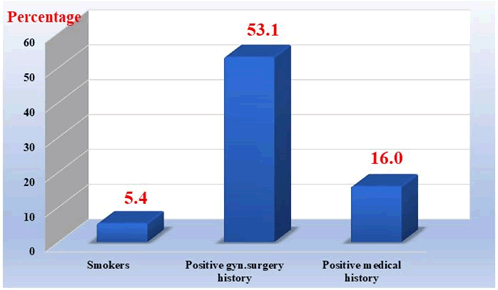
Figure 1: Distribution of studied group according to smoking, Gynecological or Obstetrical surgery and medical history (N=350).
4. Source of information of the studied group:
Most of studied group heard about menopause from mother 43.1%, followed by16.9% heard about from relatives. Others finding and other source of information are shown in figure 2.
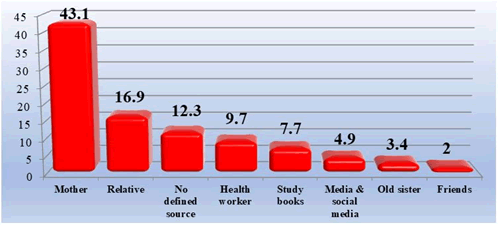
Figure 2: Proportional distribution of the studied group according to their main source of information about menopause.
Percentage
5. Responses of the studied group on the awareness questionnaire:
Awareness about symptoms and complications of menopause: Regarding the awareness of the studied group about symptoms and complications of menopause, the correct responses varies according to the symptoms, the higher proportion of participants (82%) correctly respond about the average age of menopause, while the lowest proportion of correct responses (10.9%) reported for dyspareunia. However, the overall mean score for this domain was 27.4 ± 3.2 (range 12-36) giving an evaluation of fair awareness about symptoms and complications of menopause as it show in table 3.
Moreover, 27.1% of the participant women had good, 66% had fair and 6.9% had poor awareness about symptoms and complications of
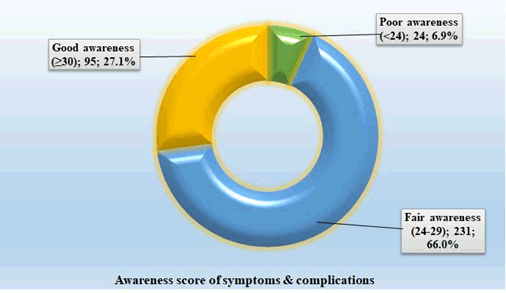
Figure 3: Distribution of the studied group according to their level of awareness about the symptoms and complications of menopause.
Awareness about applied methods for prevention of menopausal complications: As it shown in table 4, the proportions of participants who gave the correct response about the preventive measures for reducing hot flush, were 56.3 % for wearing thin shirts instead of thick and warm clothes in winter, the proportions of participants who gave the correct response about the preventive measures for reducing mood complications, were 58 % for drinking one glass of milk or yogurt before going to bed.
The proportions of participants who gave the correct response about the preventive measures for reducing osteoporosis, were 55.1% for consuming milk, yogurt and 88.6% had the correct response regarding the item of visiting doctor in case of having bleeding.
The overall awareness level of participants about this domain was fair with a mean score of 35.3 ± 4.3 (range 15-45).
Moreover, 29.1% of the participant women had good awareness about the preventive measures for reducing hot flush, 41.7% of the participant women had good awareness about preventive measures for reducing mood complications and 53.7% of the participant women had good awareness about the preventive measures for reducing osteoporosis . These finding are shown in figure 4.
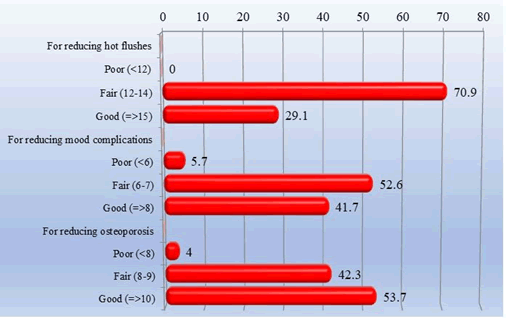
Figure 4: Proportional distribution of the studied group according to their awareness about the preventive measures of main menopausal complications.
Additionally, the distribution of studied group according to their overall awareness about the preventive measures for reducing menopausal complications revealed that 29.7% had good awareness, 68.6% had fair and 1.7% had poor awareness about preventive measures of menopausal complications as it show in figure 5.
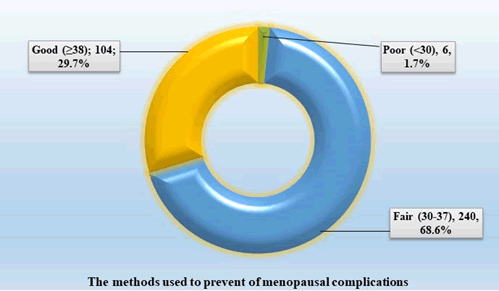
Figure 5: Distribution of the studied group according to their level of awareness about the methods used to prevent of menopausal complications.
Overall awareness about menopause (symptoms, complications and methods of prevention of its complications)
According to the mean scores reported for each domain, the mean overall awareness score was calculated and it was 62.6 ± 5.9 (range 44- 77), indicating an overall fair awareness about menopause in reproductive age group women as it show in Figure 6. awareness level about menopause.
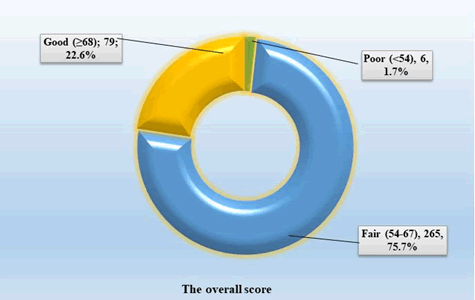
Figure 6: Distribution of the studied group according to their overall awareness level about menopause.
Relationship between awareness about symptoms& complication of menopause and sociodemographic characteristics: As it show in table 5, it had been significantly found that good awareness score was associated with women age 40-49 years, (37.1%), and the lowest proportion among the youngest age group <20 years old (919.2%), (P. Value=0.012). The other significant association was found with employee occupation, were the higher proportion of good awareness was reported among women who employee 31.6% compared to 26.1% in non- employee and 6.7% in student, (P. Value=0.031).
Also it was found that good awareness score associated with high educational level (institute/collage) 35.2% compare to 10.5% in low educational level (Illiterate). Other variable (marital status) was insignificantly associated with the overall awareness about symptoms &complications of menopause (P. Value >0.05) (Table 6).
Association between awareness about symptoms and complication of menopause with gynecological, medical and gynecological surgery history of studied group: No significant association had been found between the gynecological history of participants and awareness of them about symptoms and complications of menopause.
Association between awareness of studied group about symptoms and complications of menopause with source of information: As shown in table 7, it had been significantly found that good awareness score was associated with health worker as source of their information 50.0%, (P. Value=0.0001).
Association between awareness level of studied group about applied methods for prevention of menopausal complications with sociodemographic characteristics: As it shown in table 8, it had been found that good awareness score was associated with older age, the higher proportion of good awareness reported among the women aged 40-49 years, (37.1%), and the lowest proportion among the youngest age group <20 years old (3.8%), (P. Value=0.029). The other significant association was found with employee occupation, where the higher proportion of good awareness was reported among women who employee 45.3% compared to 21.6% in non-employee and 26.7% in student., (P. Value=0.0001).
Also show significant associated was found that good awareness score associated with high educational level (institute/collage) 50.0% compare to 24.7% in secondary and 16.0% in primary educational level.(P. Value=0.001).
Other variable (marital status) was also significantly associated with the awareness about of methods used to prevent of menopausal complications (P. Value=0.006).
Association between awareness levels of studied group about applied methods for prevention of menopausal complications with gynecological, medical and gynecological surgery history (Table 9).
No significant association had been found between the gynecological, medical & gynecological surgery history of studied group and awareness of them about of methods used to prevent of menopausal complications.
Association between awareness of studied group about methods applied to prevent of menopausal complications with source of information: It had been significantly found that good awareness score associated with health worker as source of their information 73.5%, (P. Value=0.0001), compare to37.0% from study book, 35.3% from media and social media and other finding shown in table 10.
Women attitude to menopause as positive matter: Majority of women thought that menopause was negative matter, (59%) mostly due to its complications, while 28% thought that positive matter mostly for prayer and only 13% their answers were neutral. As shown in figure 7.
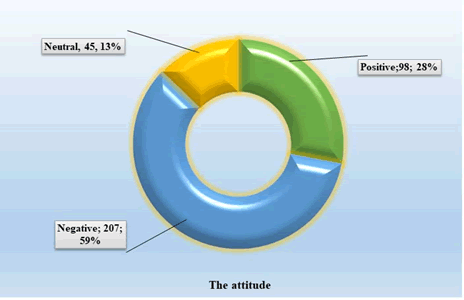
Figure 7: Distribution of studied group according to their attitude about menopause.
Discussion
Based on the results of this study, the overall level of awareness of women about menopause was as follow: 1.7% had poor, 75.7% had average and 22.6% had good level of awareness, upon comparing these results to(2 in Iran)(2,14) and in Egypt (19) showed that 0.8%, 60.8% and 38.5% had good knowledge respectively, 27.3%, 24.1%, 48.6% had good awareness respectively,74.3% had heard and had knowledge about menopause and 25.7% had not knowledgeable respectively.
Overall awareness
In our study, majority of women had fair awareness about menopause in general. An agreement observed in Elkazeh and El-Zeftawy in Egypt, were reported that 74.3% had heard and had knowledge about menopause [19].
Source of information
In the current study, source of information about menopause in the majority of studied group was family members 63.4%, mainly from mother. This result was in agreement with both studies in Iran and Egypt, who reported that mainly 26.8% and 44% of their respondent's sources were relatives and family members respectively. Since, it's expected that gynecological problems be discussed among close relatives prior to consulting professionals, because usually in closed communities, such as ours, it is awkward to openly discuss such matters with foreign doctors or health care providers [14,19].
Awareness about symptoms and complications of menopause
The awareness about symptoms and complications of menopause was poor in 6.9%, fair in 66.0% of the studied group while 27.1% of them had good awareness. Previous studies carried out in Egypt (2015), Ethiopia (2017) and Iran (2013) showed that: 25.3%, 56.3% and 18.3% had poor level of awareness respectively, 15.7%, 61.8% and 22.5% had fair level of awareness respectively, 25%, 30.9% and 44.1% had good level of awareness respectively [19,20,14].
The physiological changes of Menopause can start 10 years prior to FMP (4), 77.1% of our participants aware that menopause is a natural phenomenon. This result was in agreement with both previous studies in Iran and in Iraq/Erbil were reported that 78.6% and 85.8% of women perceived menopause as a natural condition respectively [14,5].
Menopause starts with irregular menstruation [4], 52.9% thought it starts with irregular menstruation, compared with study in Iran, reported that 71.8% of women aware that.14
In our study, majority of women believed that average age of menopause was (45-55) years. In both Iran studies, 73.6% and 77.3% of women aware about average age of menopause respectively [2,14].
While beliefs regarding symptoms and associated events, hot flush the commonest menopausal symptoms [4], 52.9% thought the most common symptom was hot flushes. While in both studies in Iran were reported 20.7% and 85.5% of them believed that respectively [2,14].
Women report more trouble sleeping as they enter into the menopausal transition, and sleep has been shown to be worse around the time of menses [12], 19.7 % of our participant agreed with this fact, compared to the Irani women , reported 58.6 % [14].
Long-term (8-10 years) or regular smokers are likely to experience menopause sooner [8-10]. Women who smoke may start menopause one to two years earlier than women who don’t smoke [21], 19.7% thought it occurs earlier in smokers. Regarding to Iran studies, were reported 43.2% and 40.8% thought that smoking affects menopausal time respectively [2,14].
Lack of estrogen affects the genital tract this is manifested by dyspareunia and vaginal bleeding from fragile atrophic skin [4],10.9% aware about dyspareunia, compared with 22.7% reported in Iran and more than half of the studied group in Iran thought that sexuality changes with menopause and intercourse becomes painful [14,2].
Menopausal changes of the lower urinary tract as dysuria, urgency and frequency, commonly termed the urethral syndrome [4], in our study, 21.7% were aware of that, compared to Iran studies they reported that 15.9% and 45.5% of women believed that dysuria increases with menopause respectively [2,14].
Long-term health problems which have been linked to the menopause are osteoporosis and heart disease [4]. About cardiovascular disease, 44.6% of our participants were aware of that, compared to 29.1% of Bakouei. F et al study group and 71% of Naroozi. E et al study group [14,2].
About osteoporosis, 18.9% of our participants aware about it, this was much lower than both studies in Iran, who reported in 78.6% and 81.8% of women whom believed that menopause increases bones fragility and osteomalacia respectively. This difference in results is justified by age difference in that our sample included reproductive age group, so their information about osteoporosis was limited in comparison to other studies that were older and could have suffered from the condition [2,14].
Menopause increases extra hair on women's face, 22.6% of our participants aware of that, compared to 50%of the women in Iran [2].
Applied methods for prevention of menopausal complications
In our study, awareness regarding to the applied methods for prevention of menopausal complications was poor in 1.7% fair in 68.6% while good in 29.7%of the participants.
Studies in Iran and Egypt showed poor awareness in 27.3%, 44.3% of them 26.8% 52.3% of them had average and 45.9%, 3.3% of them had good level of awareness of the methods applied for prevention of menopausal complications respectively [14,2].
Reducing hot flush
More than half of the current participant believed that hot flush could be reduced by wearing several thin shirts in winter and about 40% of them by avoiding hot and overcrowded places which was comparable to Iranian women, while quitting smoking as a measure to reduce hot flush was known by only 28.9% which was much lower than the study of Iran [14].
Both Iranian women and ours had a comparable awareness regarding importance of avoiding hot and spicy food to control hot flush as well as taking frequent deep breaths apart from drinking coffee which was much lower in our participants [14].
Reducing other complications
In the current study, the proportions of participants who gave the correct response about the preventive measures for reducing mood complications were 58% for drinking one glass of milk or yogurt before going to bed. 52% for adequate sleep and daily activities. 38% for read and mediation. While Bakouei. F et al (2013) in Iran [14] reported that 70.9%, 62.1% and 59.1% respectively.
Osteoporosis is more prevalent among post-menopausal women [22]. Fractures resulting from osteoporosis become increasingly common in women after age 55 years old. Taking preventive measures is the pivotal point in primary health care. The participants, who gave the correct response about the preventive measures for reducing osteoporosis, were 55.1% for consuming dairy products. Our result was similar to study done by Sugunadevi G (2017), in India, the awareness on foods to be consumed during menopause was ranging from 38% to 52% among their participants. While Bakouei F, et al (2013) in Iran reported that 84.1% believed that dairy products should be consumed to improve bone health. 51.4% for regular exercising, this was different from the reports of Bakouei F et al (2013) in Iran reported that 80.4% [23,14].
Postmenopausal women should increase intake of calcium whether tablets or syrup, 44.3% of our participants gave correct response, which was higher than the results of Iran, 33.6% [14]
More than half of participant believed that to decrease heart disease rate, quitting smoking and keeping a suitable weight are crucial; this is similar to study in Iran in 56.4% who also gave a correct response [14].
Over-the-counter lubricants and moisturizers may have some effectiveness for milder symptoms; however, for those with severe symptoms, hormonal treatment is the mainstay [4], 13.1% believed that applying lubricating creams during intercourse to reduce dyspareunia, this result different from the reports of Bakouei F et al(2013)in Iran 40.5% of them gave correct response about it [14].
In case of vaginal bleeding
The majority of the current study group were aware of the danger of post-menopausal bleeding and the importance of consulting the doctor ,also similar results was noticed in another study [87,75,14].
Relationship between awareness and socio-demographic characteristics
In this study, significantly higher awareness about symptoms and complication of menopause was found in women aged (40-49 years), employed, with higher educational levels, and those who acquired their knowledge from their mothers, while no statistically significant association was found between awareness and marital status, gynecological, medical and surgical histories. Mustafa and Sabir (2012) in Iraq/Erbil, although they studied menopaused women, they reported that knowledge regarding menopause symptoms was significantly associated with occupation, and that it was higher among skilled and professional occupations [5].
Our results partially agreed with results of Lindh-Åstrand (2009) in Sweden who studied large number of both pre and post-menopausal woman and reported that women with a lower educational level tended to be unsure about many questions compared to other with higher education. Higher educational levels are associated with more life experience and always open a road for acquiring information, from other students and teachers; in addition, educated people are usually more motivated to read and expand their knowledge [24,25].
Regarding total scores of methods used in prevention in this study, higher awareness was associated with age group (40-49) years, employee, high educational level, and marital status. Our results partially agreed with a study done by Bakouei F et al (2013) in Iran, and reported that awareness level of women about methods used for prevention of menopausal complications was significantly correlated with their job, education level, hearing or reading about menopause, and their information source [14].
Therefore, women who have satisfactory information about menopausal symptoms and complications are able to cope with it more efficiently and seek appropriate management. Menopause is a natural occurring phenomenon, which will face all women; however, awareness regarding its complication needs to be dealt with. When women during this period are not aware of what is happening to them, it may lead to more stressful transition period [26].
In our study, 28% of women had positive attitude toward menopause mostly due to prayer. Our result was partially agreement with study in Iraq/Erbil, 47% of women had positive attitude toward menopause [5].
This result was different from study by Noroozi E et al(2013) in Iranreported 81.5%was positive, only 18.5% had a negative attitude toward this phenomenon. For example, more than 70% of the women agreed with the fact that woman's life in the menopause period is more delightful than before, or more than 67% of them knew menopause as a comfortable period of menstruation problems and pregnancy prevention [2].
Conclusion
1. Majority of women had fair awareness regarding menopause symptoms, complications and prevention
2. Factors that have significant association with the awareness level were: age, source of information, educational level and employment.
References
- Ceylan B, ÖzerdoÄ?an N (2015) Factors affecting age of onset of menopause and determination of quality of life in menopause. Turk J Obstet Gynecol. 12(1): 43-49.
- Noroozi E, Dolatabadi NK, Eslami AA, Hassanzadeh A (2013) Knowledge and attitude toward menopause phenomenon among women aged 40-45 years. J Educ Health Promot. 2: 25.
- Paulman PM, Paulman AA, Jarzynka KJ, Falk NP. Taylor's anual of Family Medicine (4th edn), p-485.
- Panay N. Dewhurt's textbook of Obstetric and Gynocology (7th edn) Menopause and the postmenopausal women, p-479.
- Mustafa GN, Sabir JM (2012) Perception and experience regarding menopause among menopaused women attending teaching hospitals in Erbil City. Glob J Health Sci. 4(3): 170-180.
- Rahman SASA, Zainudin SR, Mun VLK (2010) Assessment of menopausal symptoms using modified Menopause Rating Scale (MRS) among middle age women in Kuching, Sarawak, Malaysia. Asia Pac Fam Med. 9(1): 5.
- Singh N, Shinde M, Dafal H, Trivedi A (2018) Age at natural menopause and factors affecting menopausal age. Int j health med. 7(12): 994-1001.
- Yang HJ, Suh PS, Kim SJ, Lee SY (2015) Effects of Smoking on Menopausal Age: Results From the Korea National Health and Nutrition Examination Survey, 2007 to 2012) J Prev Med Public Health. 48(4): 216-224.
- Hayatbakhsh MR, Clavarino A, Williams GM, Sina M and Najman JM (2012) Cigarette smoking and age of menopause: A large prospective study Maturitas. j maturitas. 72(4): 346-352.
- Sun L, Tan L, Yang F, Luo Y, Li X (2012) Meta-analysis suggests that smoking is associated with an increased risk of early natural menopause Menopause. NAMS. 19(2): 126-132.
- Nayak G, Kamath A, Kumar P, Rao A (2012) A study of quality of life among perimenopausal women in selected coastal areas of Karnataka, India. J Midlife Health. 3(2): 71-75.
- Santoro N, Epperson CN, Mathews SB (2015) Menopausal Symptoms and Their Management. Endocrinol Metab Clin North Am. 44(3): 497-515.
- Kwak EK, Park HS, Kang NM (2014) Menopause knowledge, attitude, symptom and management among midlife employed women. J Menopausal Med. 20(3): 118-125.
- Bakouei F, Basirat Z, Salmalian H, Omidvars (2013) Assessment of women’s awareness level about symptoms and complications of menopause and methods to their prevention. Glob J Health Sci. 1(1): 6.
- Vaze N and Joshi S (2010) Yoga and menopausal transition. J Midlife Health. 1(2): 56.
- Christian DS, Kathad MM and Bhavsar BS (2012) A clinico-epidemiological study on health problems of post-menopausal women in rural area of Vadodara District, Gujarat. Natl J Med Res. 110: 74-78.
- Knoema (2019) Iraq-Female life expectancy at birth. World Data Atlas. 72: 2.
- Mahadeo BS, Vaishali RM (2014) A Study to Assess Knowledge, Attitude and Practices of Five Moments of Hand Hygiene among Nursing Staff and Students at a Tertiary Care Hospital at Karad. IJSR. 3(2): p-316.
- Elkazeh E, El-Zeftawy A (2015) Knowledge of Women in Reproductive Age about Menopausal Problems and Preventive Health Behaviors in Tanta City. J Nur Health Sci. 4(3): 51-63.
- Eshetu N, Ly S, Yisma E (2017) Knowledge and Attitude of Women Aged 30-49 Years towards Menopause in Gulele Sub-City of Addis Ababa, Ethiopia. Annals of Global Health. 1(83): 107.
- Stolk L, Perry JRB, Murray A, Murabito JM, Visser JA (2012) Meta-analyses identify 13 novel loci associated with age at menopause and highlights DNA repair and immune pathway. Nat Genet. 44(3): 260-268.
- Compston JE, McClung MR, Leslie WD (2019) Osteoporosis. Pubmed. 393(10169): 364-376.
- Sugunadevi G, Divya BV (2018) Health education program about postmenopausal changes to perimenopausal women in an urban slum area, Coimbatore. IJMSPH. 7(3): 193-197.
- Åstrand L, Lotta () Women's knowledge, attitudes, and management of the menopausal transition. Department of Clinical and Experimental Medicine, Division of Women and Child Health Obstetrics and Gynecology, Faculty of Health Sciences, Linköping University, 581 83 Linköping, Sweden Linköping University Medical Dissertations, 53(1): 9.
- Jassim G (2018) Introducing women’s health in the higher education curriculum: An innovative experience in advancing women’s health. Med Ed Publish. 7(3): 76.
- Simarjeet K, Vandana V, Patial N (2018) Assessment of knowledge of menopausal women regarding menopause: A descriptive study. IJAR. 4(4): 347-351.
 Spanish
Spanish  Chinese
Chinese  Russian
Russian  German
German  French
French  Japanese
Japanese  Portuguese
Portuguese  Hindi
Hindi 



